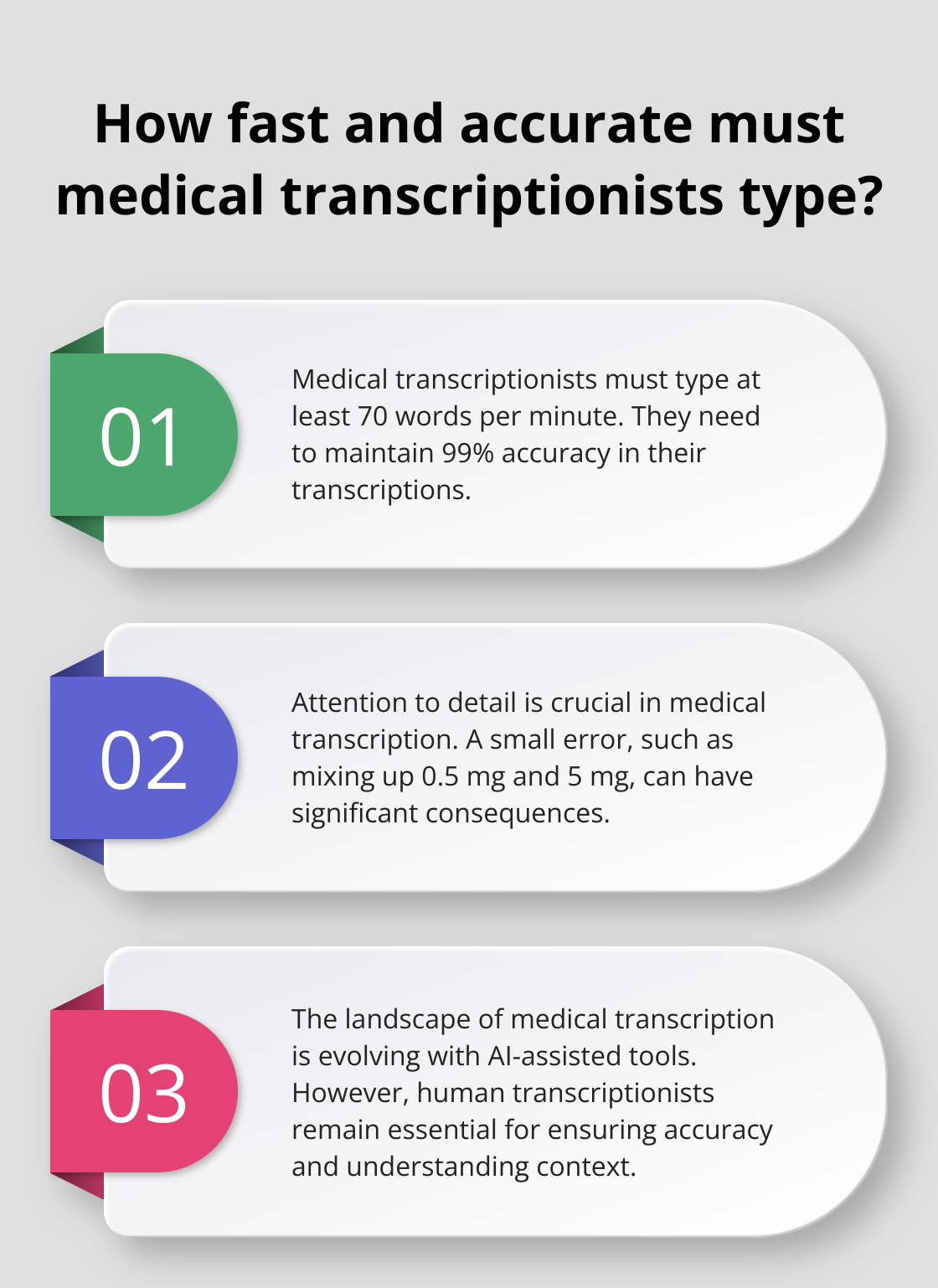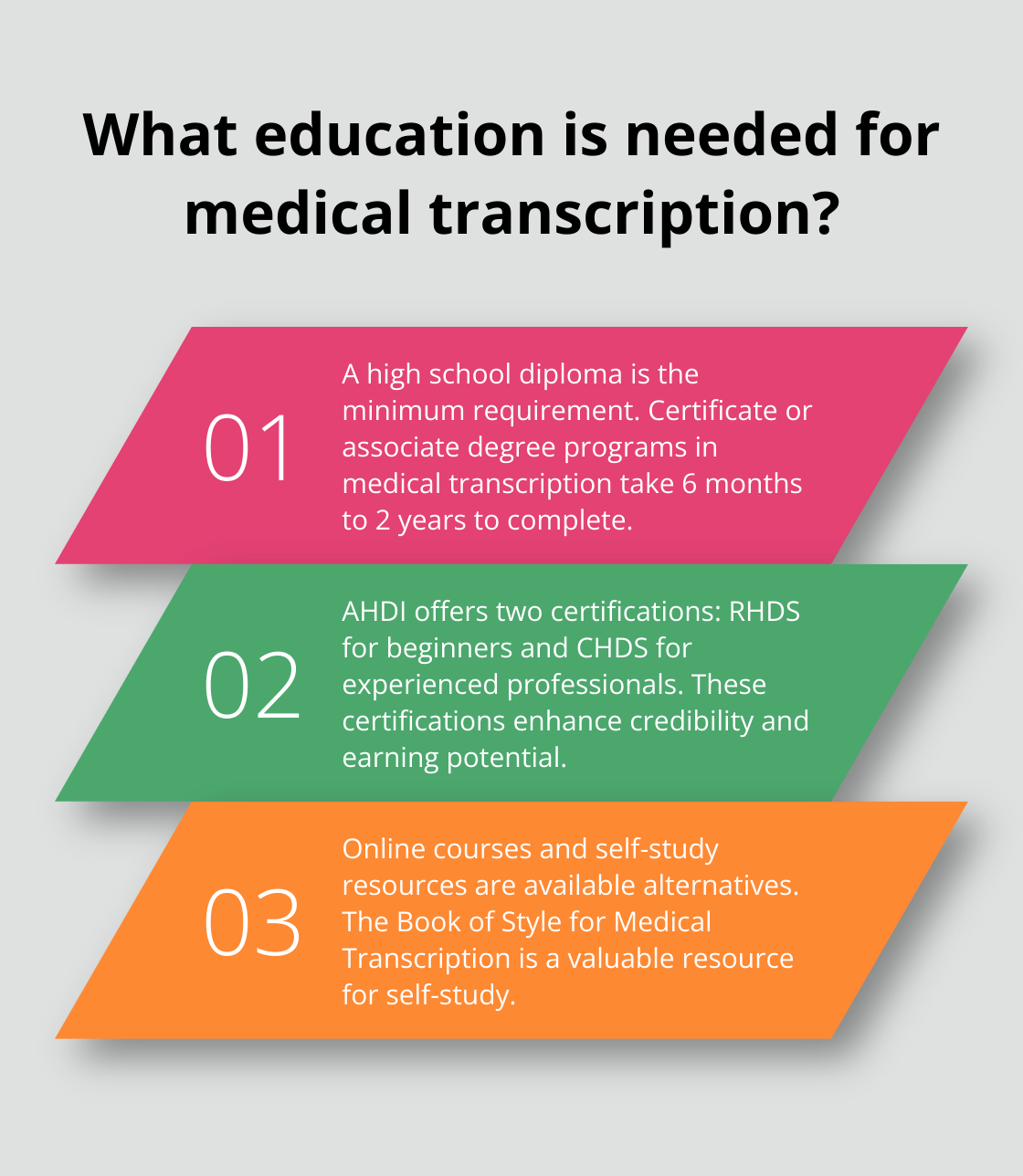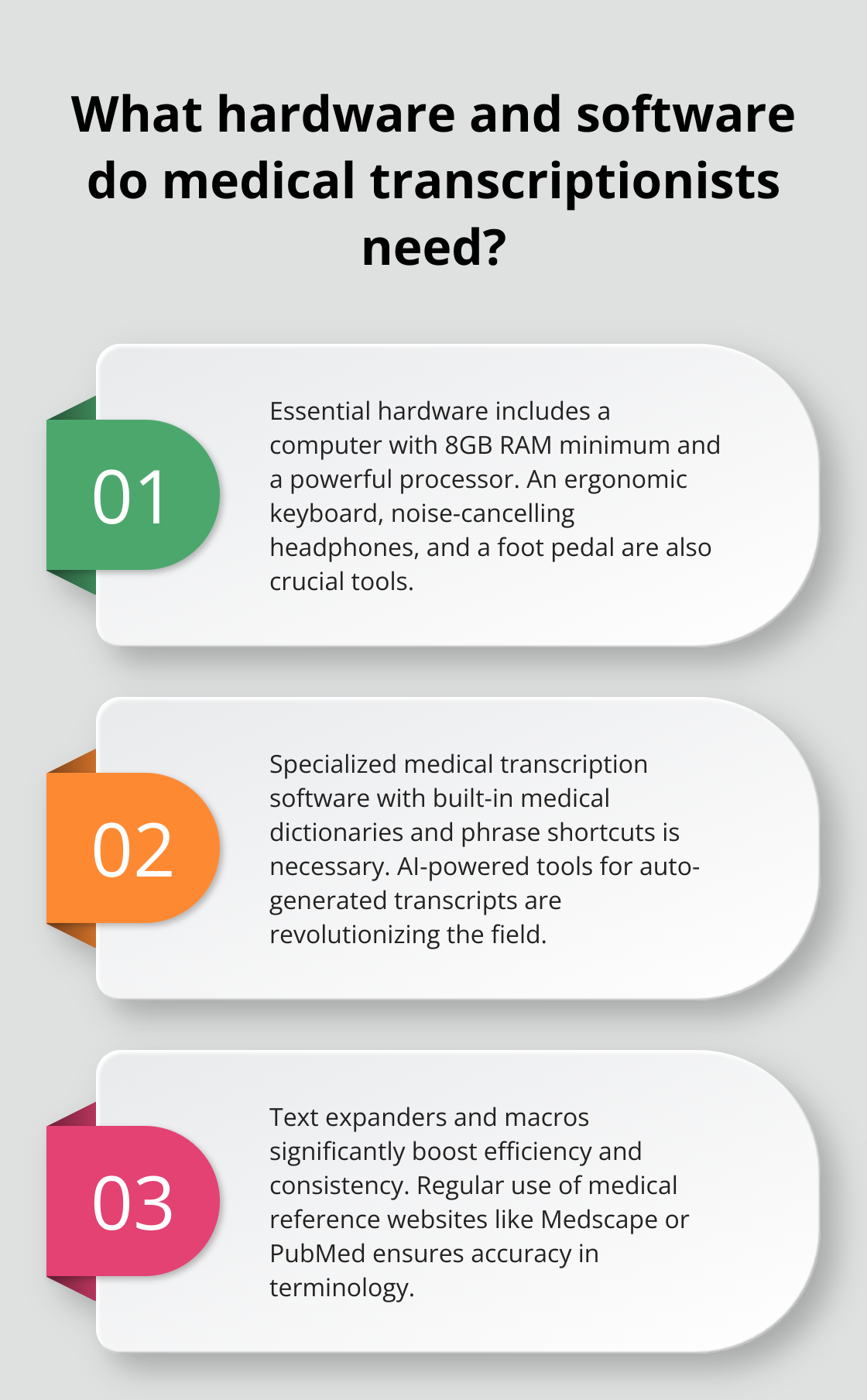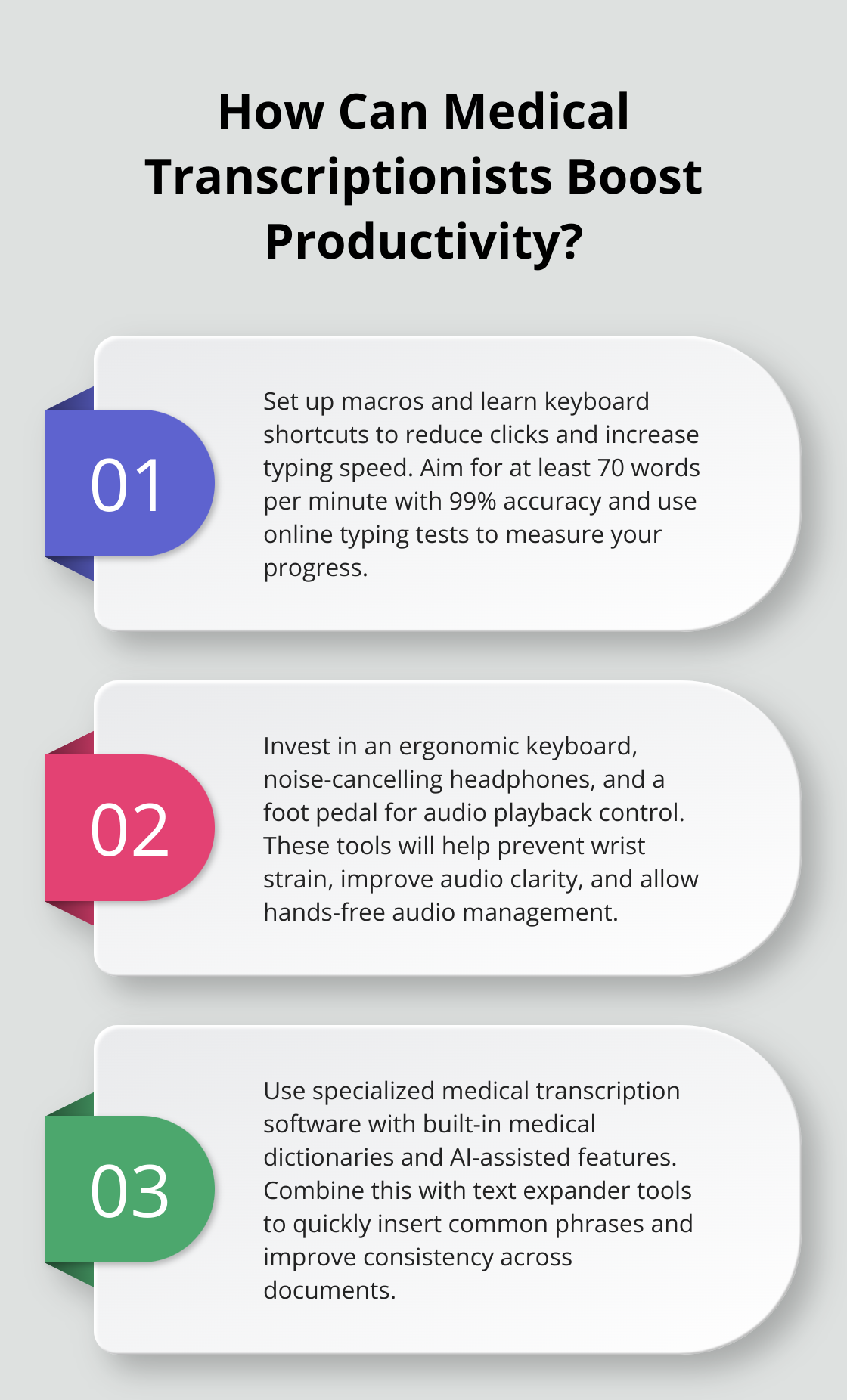So, let’s talk medical transcription… It’s kind of the unsung hero in the healthcare world. Doctors do their thing, but without precise documentation—someone’s gonna mess up. Enter the transcriber. At ScriberJoy, we’ve realized—this gig isn’t just essential, it’s a sweet career path for word nerds with a razor-sharp eye for detail.
Think you’ve got what it takes? This quick guide is your first class ticket to conquering the medical transcription domain. We’ll stroll through the ABCs of training—what you need to know and the tech that’ll make you the Usain Bolt of transcription. (Because being fast and accurate isn’t just a goal, it’s the whole game).
What Is Medical Transcription?
The Core of Medical Transcription
Medical transcription-let’s break it down. It’s turning those voice-garbled medical ramblings into crisp, clear documents. It’s a crucial cog in the healthcare machine-making sure docs have accurate, complete, and ready-at-the-fingertips records.

Here’s the deal: You listen to docs and nurses drone on, then type it all out. But it’s not just about typing speed. Transcriptionists? They’ve got to be medical linguists-parsing through the jargon, deciphering accents from all corners, and catching errors that could lead to a medical mishap.
Medical transcriptionists aren’t just typists-they’re tech-savvy pros converting voice snippets into formal reports. What’s the real kicker here? The job’s flexible as all get-out and ripe for growth.
Essential Skills for Top Transcriptionists
Think you can just tap away? Nah, it’s a bit deeper than that. Here’s what separates the wheat from the chaff:
- Typing Speed and Accuracy: You gotta hit at least 70 words per minute-99% accuracy, folks. (Yes, we checked our own math.) Online tests? Your new best friend.
- Medical Knowledge: Anatomy, physiology, pharmacology-get cozy with them. Deciphering medical lingo? That makes or breaks your career, my friend.
- Attention to Detail: A decimal here or there-big difference. (Trust me, mixing up 0.5 mg and 5 mg isn’t something you wanna do.) Eagle eyes, people.
- Tech Savvy: Master the gizmos-transcription software, EHR systems. Hospitals have their quirks-you gotta dance to their tune.
The Evolving Landscape of Medical Transcription
Buckle up-things are changing. Old-school transcription gigs? They’re shrinking ’cause of speech recognition tech. But hey, adapt and you’ll find new doors swinging wide open.
Enter AI-assisted transcription tools-game-changers. They ramp up efficiency, so you can zero in on quality and those head-scratching cases. (ScribeJoy? A top contender-mixes AI with human finesse for stellar accuracy.)
Yet-hold the phone-the human angle’s irreplaceable. A Journal of the American Medical Association study? It showed AI notes still needed a human polish. Skilled transcriptionists? They’re the bridge between AI and reality, navigating context and subtleties.
As the industry shifts, consider going niche-radiology, pathology. These areas demand deeper expertise and pay better. Cha-ching!
Next up-dive into the education and training options. We’ll map it out for those itching to kickstart a career in this lucrative field.
How to Get the Right Training for Medical Transcription
Think typing fast is enough for medical transcription? Think again. We’re talking precision, a knack for decoding fancy medical jargon, and a firm grasp on the ever-evolving world of healthcare. Let’s dive into what you actually need to nail this.
Formal Education and Certifications
Start with the basics – a high school diploma. But want to really shine? Level up with a certificate or associate degree in medical transcription. These bad boys usually take 6 months to 2 years (because speed ain’t everything). You’ll delve into medical lingo, human anatomy, the ins and outs of healthcare docs, and, oh yeah, legal stuff too.

Now, enter the AHDI – they hand out two shiny certifications that scream, “Yep, I’m legit”:
- Registered Healthcare Documentation Specialist (RHDS) for newbies
- Certified Healthcare Documentation Specialist (CHDS) for those who’ve been around the block (two years in acute care, anyone?)
These titles? Gold dust for your credibility and paycheck.
Online Courses and Self-Study Resources
Sitting in a classroom got you feeling stuck? The internet’s your playground. Loads of sites serve up legit medical transcription courses. Learn when you want, where you want, and often for less dough than the traditional route.
Going the self-study way? Stack up on medical dictionaries and style guides. The Book of Style for Medical Transcription – your new best friend. Don’t forget online forums and pro groups for networking (and some brain-picking).
Continuous Learning in Medical Terminology
Medicine never stands still. New drugs, procedures, weird-sounding treatments-they keep on coming. To stand your ground, you better strap in for the lifelong learning ride.
Sign up for journals or newsletters in your wheelhouse. Webinars? Conferences? Go for ’em. Tons of hospitals and healthcare groups even throw education programs your way – snag those opportunities.
It’s not just about the words – it’s the context, the big picture. That’s what sets the good apart from the great in transcription land.
And yeah, AI is shaking things up. But guess what? It still needs your human touch to catch those tricky nuances. Your command of medical vocab remains a heavy hitter.
In this wild, fast-paced world, your thirst for knowledge and adaptability are your standout traits. Stay curious, stay sharp, and keep ahead in your transcription adventure.
Now you’re all clued up on education – let’s get into the tech and tools that’ll ramp up your transcription game. (Trust me, these gadgets will be your go-to as you plunge into this thrilling field.)
What Tech Do Medical Transcriptionists Need?
Essential Hardware for Transcription
So, you’re diving into medical transcription, huh? You’re gonna need more than just speedy fingers. Let’s talk gadgets-because without the right gear, you’re just typing gibberish. First stop, a solid computer. Think minimum 8GB RAM, a gutsy processor to juggle all those audio files and docs you’ve got coming. It’s your command center, folks.

Keyboards and headphones-your bread and butter tools. Grab an ergonomic keyboard, unless you enjoy wrist braces (spoiler: you won’t). Hunting for headphones? Go noise-cancelling. Doctors don’t always speak as clearly as you’d hope, trust me.
And hey, don’t skip the foot pedal. Old-school? Maybe. Essential? Definitely. Keeping your hands on the keyboard while managing playback? Game-changer.
Software to Boost Productivity
A word processor is your warm-up, not the main event. Pump up your game with specialized medical transcription software. We’re talking built-in medical dictionaries, phrase shortcuts, and some voice recognition magic.
Then there’s AI-revolutionizing your world, one auto-generated transcript at a time. AI handles the grunt work, so you can polish and perfect like a pro.
Maximizing Accuracy and Efficiency
But all this tech? Useless if you don’t wield it like a boss. Set up macros like you’re hacking the Matrix. Learn keyboard shortcuts-make them second nature. Fewer clicks mean faster work.
Remember, speed thrills but accuracy kills (in the good way). Double-check everything with top-notch medical references. Websites like Medscape or PubMed? They’re your new best friends for term verification.
Ever heard of a text expander? Start using it yesterday. Type a little, expand a lot. It’s a time-saver and keeps every doc consistent.
Staying Current with Technology
Here’s the deal-medical transcription is a fast-moving train. Keep pace with new software updates and the latest tech chatter. Join forums, sign up for some professional groups-these are your lifelines for what’s new and what works.
And don’t stop at fancy vocab. Get cozy with the latest transcription software and AI tools. Staying sharp is the key to staying employed and upping your efficiency game.
Final Thoughts
So you’re thinking about a career in medical transcription? Let’s dive in. It’s all about merging language chops, medical smarts, and tech savvy. We’re talking precise typing, mastering those medical terms, and staying on top of tech trends. The game’s changing fast-AI and speech recognition are shaking things up. This means fresh prospects for pros who can handle both the old-school and the cutting-edge.

Check it out-ScribeJoy. They’ve got this slick solution that blends AI wizardry with human checks for super-accurate medical docs. Translation: they make the transcription gig easier so docs can zero in on what really matters-patients. It’s like the perfect mix of healthcare know-how and geek skills. Plus, it’s a dream for those wanting some job flexibility.
Ready to jump into medical transcription? Time to hit the books, sharpen those skills, and cozy up to the tech shaping tomorrow’s workplace. The healthcare world’s always on the hunt for solid documentation, and with the right prep, you could be their go-to (and seriously crush it in your new role).

Leave a Reply
You must be logged in to post a comment.